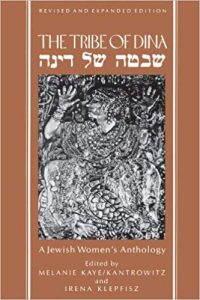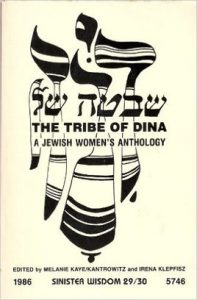In 1986, the radical lesbian feminist periodical Sinister Wisdom published a themed issue titled “The Tribe of Dina.” It spans two of the four annual publications of Sinister Wisdom, making it both issue 29 and 30. The publication was so successful upon release that it was published as its own book called “The Tribe of Dina: A Jewish Women’s Anthology” in 1989. Dina is a Biblical character, the only daughter of Jewish forefather Jacob and his wife Leah, whose brothers founded the twelve tribes of Israel. Dina is only referenced as an accessory to her powerful male relatives, except for a short anecdote about how she left Israel to seek other women. “The Tribe of Dina” is presumably the women Dina sought out in response to her controlling brothers. In using this title, editors of the periodical Melanie Kaye/Kantrowitz and Irena Klepfisz reclaim the potential of the tribe of women that never materialized. As the purpose of Sinister Wisdom is to foster a specific lesbian-feminism that includes all women across any number of diversities, “Dina” (as this issue came to be known) is a microcosm of this principle. The editors used this special issue to create a community of Jewish feminists that bridges generations, classes, races, ethnicities, sexual orientations and cultural contexts.
Dina is a Biblical character, the only daughter of Jewish forefather Jacob and his wife Leah, whose brothers founded the twelve tribes of Israel. Dina is only referenced as an accessory to her powerful male relatives, except for a short anecdote about how she left Israel to seek other women. “The Tribe of Dina” is presumably the women Dina sought out in response to her controlling brothers. In using this title, editors of the periodical Melanie Kaye/Kantrowitz and Irena Klepfisz reclaim the potential of the tribe of women that never materialized. As the purpose of Sinister Wisdom is to foster a specific lesbian-feminism that includes all women across any number of diversities, “Dina” (as this issue came to be known) is a microcosm of this principle. The editors used this special issue to create a community of Jewish feminists that bridges generations, classes, races, ethnicities, sexual orientations and cultural contexts.
 In their editor’s notes, Melanie Kaye/Kantrowitz and Irena Klepfisz write that “Dina” has a dual purpose: first, to create “coalitions among Jews…..and to connect Sephardic and Ashkenazi Jews, observant and secular, gay and heterosexual, on issues of concern to some or all of us” (345), and second, to fight antisemitism as it intersects with sexism, racism, xenophobia, and classism to oppress Jewish women and all women. Kaye/Kantrowitz and Klepfisz partition the periodical by themes common in Jewish liturgy and communities. The sections each contain poetry, fiction writing, scholarship, and records of family histories: “My Ancestors Speak,” “The Women of Our Family,” “I am the Present Generation,” “Lot’s Wife Revisited,” “Kol Haisha: Israeli Women Speak,” and “Bread and Roses.” The back of the issue contains a glossary of Yiddish and Hebrew words and the graphic credits. Unlike other issues of Sinister Wisdom, “Dina” contains text in three languages (Yiddish, Hebrew, and English), as well as what appear to be family photographs. For example, an ornate border decorates the title page of the chapter “The Women of Our Family” and encloses a grouping of photographs of the writers featured in the chapter. They are of different ages, generations, ethnicities, and religious traditions. This grouping of portraits support “Dina’s” overarching theme of generational connection between Jewish women that is used as a model for creating other types of connection in the literature. As traditional Jewish cultures emphasize the bonds between generations of Jews, “Dina” strives to forge connections between Jewish women beyond those of similar lineage.
In their editor’s notes, Melanie Kaye/Kantrowitz and Irena Klepfisz write that “Dina” has a dual purpose: first, to create “coalitions among Jews…..and to connect Sephardic and Ashkenazi Jews, observant and secular, gay and heterosexual, on issues of concern to some or all of us” (345), and second, to fight antisemitism as it intersects with sexism, racism, xenophobia, and classism to oppress Jewish women and all women. Kaye/Kantrowitz and Klepfisz partition the periodical by themes common in Jewish liturgy and communities. The sections each contain poetry, fiction writing, scholarship, and records of family histories: “My Ancestors Speak,” “The Women of Our Family,” “I am the Present Generation,” “Lot’s Wife Revisited,” “Kol Haisha: Israeli Women Speak,” and “Bread and Roses.” The back of the issue contains a glossary of Yiddish and Hebrew words and the graphic credits. Unlike other issues of Sinister Wisdom, “Dina” contains text in three languages (Yiddish, Hebrew, and English), as well as what appear to be family photographs. For example, an ornate border decorates the title page of the chapter “The Women of Our Family” and encloses a grouping of photographs of the writers featured in the chapter. They are of different ages, generations, ethnicities, and religious traditions. This grouping of portraits support “Dina’s” overarching theme of generational connection between Jewish women that is used as a model for creating other types of connection in the literature. As traditional Jewish cultures emphasize the bonds between generations of Jews, “Dina” strives to forge connections between Jewish women beyond those of similar lineage.
